Burt A. The Evolution of the British Empire and Commonwealth From the American Revolution
Подождите немного. Документ загружается.

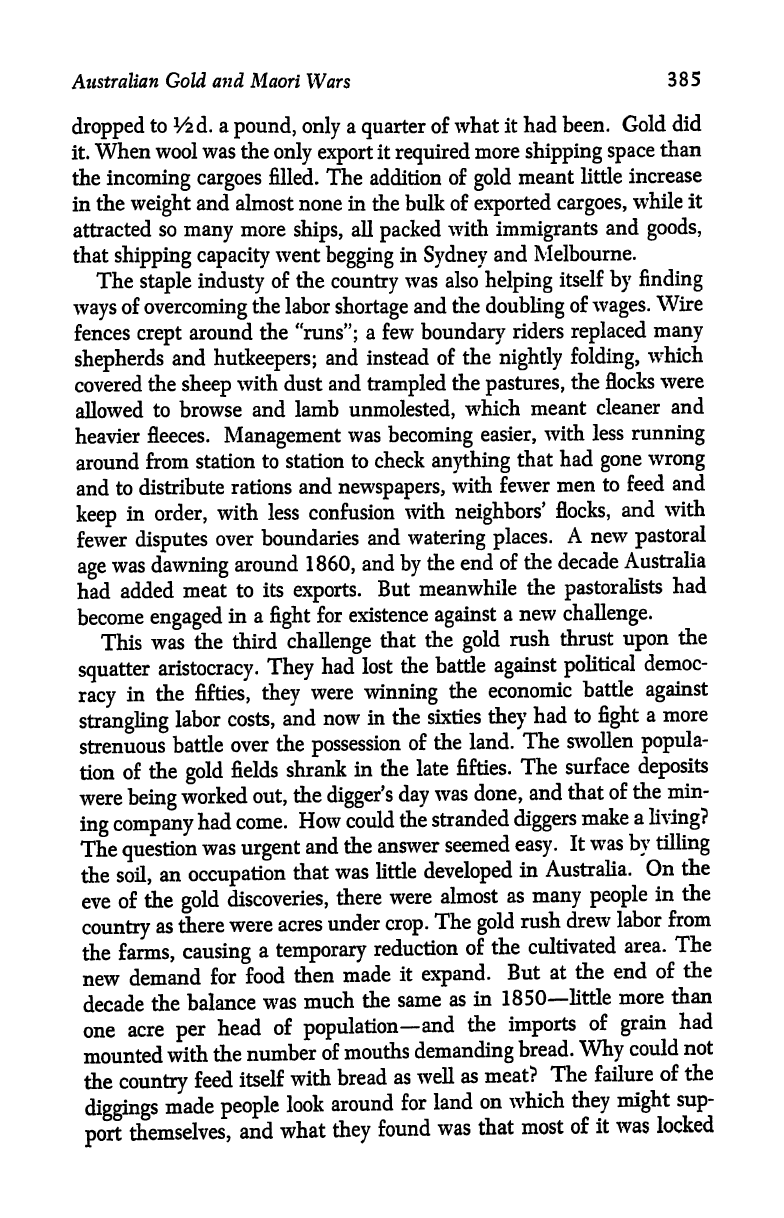
Australian
Gold and
Maori
Wars
385
dropped
to
Vd.
a
pound,
only
a
quarter
of
what
it had
been.
Gold
did
it.
When
wool was the
only
export
it
required
more
shipping
space
than
the
incoming cargoes
filled. The addition
of
gold
meant
little
increase
in
the
weight
and almost none in
the
bulk of
exported
cargoes,
while
it
attracted
so
many
more
ships,
all
packed
with
immigrants
and
goods,
that
shipping
capacity
went
begging
in
Sydney
and
Melbourne.
The
staple
industy
of the
country
was also
helping
itself
by
finding
ways
of
overcoming
the
labor
shortage
and
the
doubling
of
wages.
Wire
fences
crept
around the
"runs";
a
few
boundary
riders
replaced
many
shepherds
and
hutkeepers;
and
instead of
the
nightly
folding,
which
covered
the
sheep
with
dust
and
trampled
the
pastures,
the flocks
were
allowed
to browse
and
lamb
unmolested,
which
meant
cleaner
and
heavier
fleeces.
Management
was
becoming
easier,
with less
running
around
from
station
to
station to
check
anything
that
had
gone
wrong
and
to
distribute
rations
and
newspapers,
with
fewer
men
to feed
and
keep
in
order,
with less confusion
with
neighbors'
flocks,
and
with
fewer
disputes
over boundaries
and
watering
places.
A new
pastoral
age
was
dawning
around
1860,
and
by
the end
of
the decade
Australia
had
added
meat
to
its
exports.
But
meanwhile
the
pastoralists
had
become
engaged
in
a
fight
for
existence
against
a
new
challenge.
This
was
the
third
challenge
that
the
gold
rush
thrust
upon
the
squatter
aristocracy.
They
had
lost
the
battle
against
political
democ-
racy
in
the
fifties,
they
were
winning
the
economic
battle
against
strangling
labor
costs,
and
now
in
the
sixties
they
had
to
fight
a
more
strenuous
battle
over
the
possession
of
the
land.
The
swollen
popula-
tion
of
the
gold
fields
shrank
in
the
late
fifties.
The surface
deposits
were
being
worked
out,
the
digger's
day
was
done,
and
that
of
the
min-
ing
company
had
come.
How could
the
stranded
diggers
make
a
living?
The
question
was
urgent
and
the
answer
seemed
easy.
It
was
by
tilling
the
soil,
an
occupation
that
was
little
developed
in
Australia.
On
the
eve
of
the
gold
discoveries,
there
were
almost
as
many people
in
the
country
as
there
were
acres
under
crop.
The
gold
rush
drew
labor
from
the
farms,
causing
a
temporary
reduction
of
the
cultivated
area.
The
new
demand
for
food
then
made
it
expand.
But
at
the
end
of
the
decade
the
balance
was
much
the
same
as
in
1850
little
more
than
one
acre
per
head
of
population
and
the
imports
of
grain
had
mounted
with
the
number
of
mouths
demanding
bread.
Why
could
not
the
country
feed
itself
with
bread
as
well
as
meat?
The
failure
of
the
diggings
made
people
look
around
for
land
on
which
they
might
sup-
port
themselves,
and
what
they
found
was
that
most
of
it
was
locked
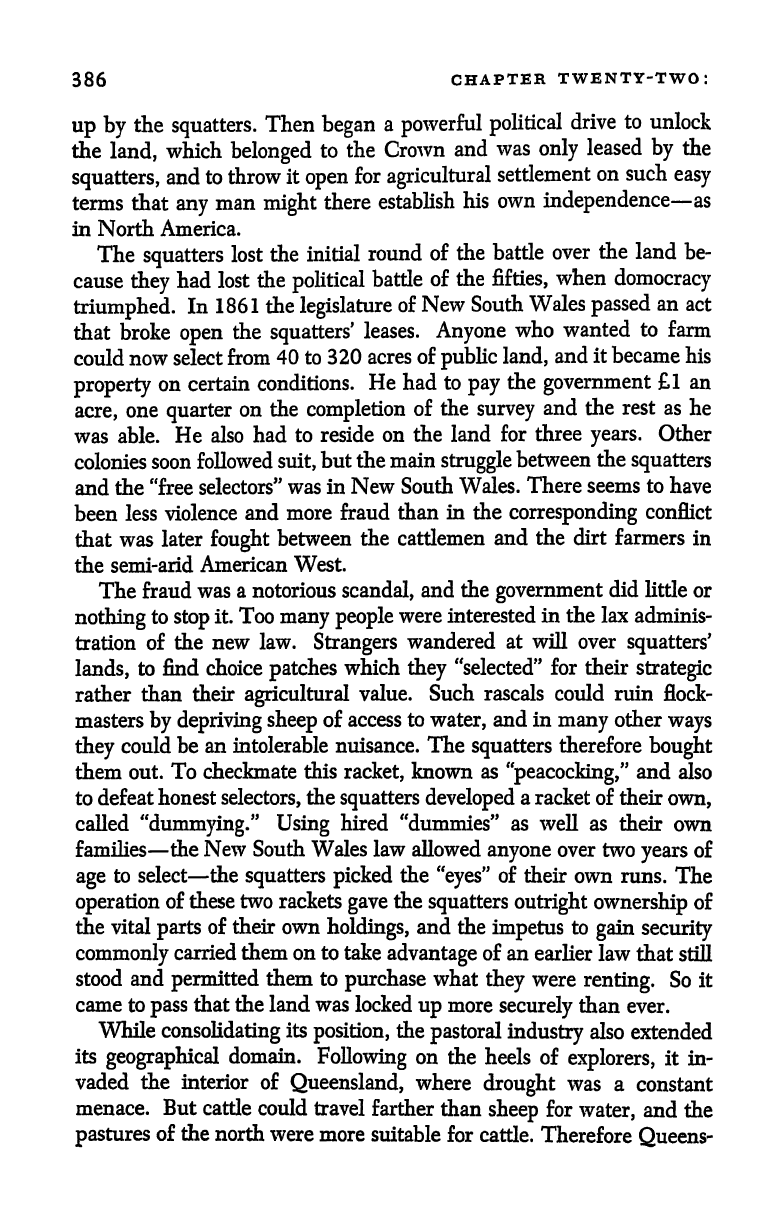
386
CHAPTER
TWENTY-TWO:
up
by
the
squatters.
Then
began
a
powerful
political
drive
to
unlock
the
land,
which
belonged
to
the
Crown
and
was
only
leased
by
the
squatters,
and to throw
it
open
for
agricultural
settlement
on such
easy
terms
that
any
man
might
there
establish
his own
independence
as
in North
America.
The
squatters
lost
the
initial
round
of
the
battle
over
the
land
be-
cause
they
had
lost
the
political
battle
of
the
fifties,
when
democracy
triumphed.
In
1861
the
legislature
of New
South
Wales
passed
an
act
that broke
open
the
squatters
1
leases.
Anyone
who
wanted
to
farm
could
now select
from
40
to 320
acres of
public
land,
and
it
became
his
property
on certain
conditions.
He had to
pay
the
government
1
an
acre,
one
quarter
on the
completion
of
the
survey
and the
rest
as
he
was
able.
He
also
had
to reside
on the land
for
three
years.
Other
colonies
soon
followed
suit,
but
the main
struggle
between
the
squatters
and
the
"free selectors"
was in New
South Wales.
There
seems
to
have
been
less
violence
and
more fraud
than
in
the
corresponding
conflict
that
was
later
fought
between
the cattlemen
and the dirt farmers
in
the semi-arid
American
West.
The fraud
was
a
notorious
scandal,
and
the
government
did
little
or
nothing
to
stop
it. Too
many people
were
interested in the lax
adminis-
tration of
the new
law.
Strangers
wandered
at
will over
squatters'
lands,
to
find choice
patches
which
they
"selected" for their
strategic
rather
than their
agricultural
value.
Such rascals
could ruin
flock-
masters
by
depriving
sheep
of
access to
water,
and in
many
other
ways
they
could
be
an intolerable nuisance.
The
squatters
therefore
bought
them
out.
To
checkmate this
racket,
known as
"peacocking,"
and
also
to
defeat
honest
selectors,
the
squatters developed
a racket of their
own,
called
"dummying."
Using
hired "dummies" as well as
their
own
families
the New South Wales law allowed
anyone
over two
years
of
age
to
select the
squatters picked
the
"eyes"
of
their
own runs.
The
operation
of these two rackets
gave
the
squatters
outright
ownership
of
the vital
parts
of
their
own
holdings,
and the
impetus
to
gain
security
commonly
carried
them
on to take
advantage
of an
earlier
law that
still
stood
and
permitted
them
to
purchase
what
they
were
renting.
So it
came
to
pass
that the
land
was
locked
up
more
securely
than
ever.
While
consolidating
its
position,
the
pastoral
industry
also
extended
its
geographical
domain.
Following
on
the heels
of
explorers,
it in-
vaded
the
interior of
Queensland,
where
drought
was a
constant
menace.
But
cattle could
travel farther
than
sheep
for
water,
and the
pastures
of the
north were
more
suitable
for cattle.
Therefore
Queens-
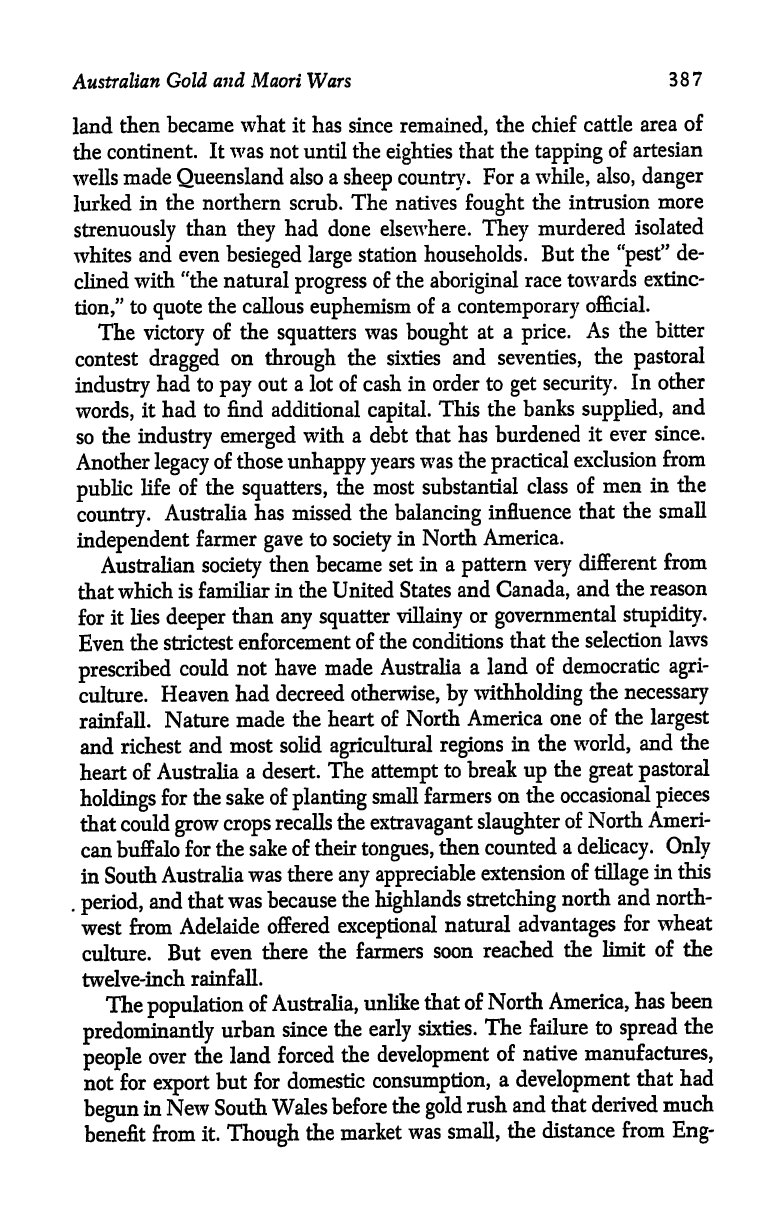
Australian
Gold
and
Maori
Wars
387
land
then
became what it
has
since
remained,
the chief
cattle
area
of
the
continent.
It was not
until
the
eighties
that the
tapping
of
artesian
wells
made
Queensland
also
a
sheep
country.
For a
while,
also,
danger
lurked
in the
northern
scrub.
The
natives
fought
the
intrusion
more
strenuously
than
they
had done
elsewhere.
They
murdered
isolated
whites
and
even
besieged
large
station households.
But
the
"pest"
de-
clined
with
"the
natural
progress
of
the
aboriginal
race
towards
extinc-
tion,"
to
quote
the
callous
euphemism
of
a
contemporary
official.
The
victory
of
the
squatters
was
bought
at
a
price.
As
the bitter
contest
dragged
on
through
the sixties
and
seventies,
the
pastoral
industry
had to
pay
out a
lot
of cash
in order
to
get
security.
In
other
words,
it had
to find additional
capital.
This
the
banks
supplied,
and
so
the
industry emerged
with a debt
that
has burdened
it
ever
since.
Another
legacy
of those
unhappy
years
was
the
practical
exclusion
from
public
life
of
the
squatters,
the
most substantial
class
of
men
in
the
country.
Australia
has missed
the
balancing
influence
that
the small
independent
farmer
gave
to
society
in North
America.
Australian
society
then
became
set
in
a
pattern
very
different
from
that
which
is
familiar
in
the United
States
and
Canada,
and
the
reason
for
it lies
deeper
than
any squatter
villainy
or
governmental
stupidity.
Even
the
strictest
enforcement
of
the
conditions
that
the
selection
laws
prescribed
could not
have
made Australia
a
land
of
democratic
agri-
culture.
Heaven
had
decreed
otherwise,
by
withholding
the
necessary
rainfall.
Nature
made
the heart
of
North
America
one
of
the
largest
and
richest
and most
solid
agricultural
regions
in
the
world,
and
the
heart
of
Australia
a
desert.
The
attempt
to break
up
the
great
pastoral
holdings
for the sake
of
planting
small
farmers
on
the occasional
pieces
that
could
grow
crops
recalls
the
extravagant
slaughter
of North
Ameri-
can
buffalo
for
the sake
of
their
tongues,
then counted
a
delicacy.
Only
in South
Australia
was there
any
appreciable
extension
of
tillage
in
this
.
period,
and
that
was because
the
highlands
stretching
north
and
north-
west
from
Adelaide
offered
exceptional
natural
advantages
for
wheat
culture.
But
even
there
the
farmers
soon
reached
the
limit
of
the
twelve-inch
rainfall.
The
population
of
Australia,
unlike
that of
North
America,
has been
predominantly
urban
since
the
early
sixties.
The
failure
to
spread
the
people
over
the
land
forced
the
development
of
native
manufactures,
not
for
export
but
for
domestic
consumption,
a
development
that
had
begun
in New
South
Wales
before
the
gold
rush
and that
derived
much
benefit
from
it.
Though
the
market
was
small,
the
distance
from
Eng-
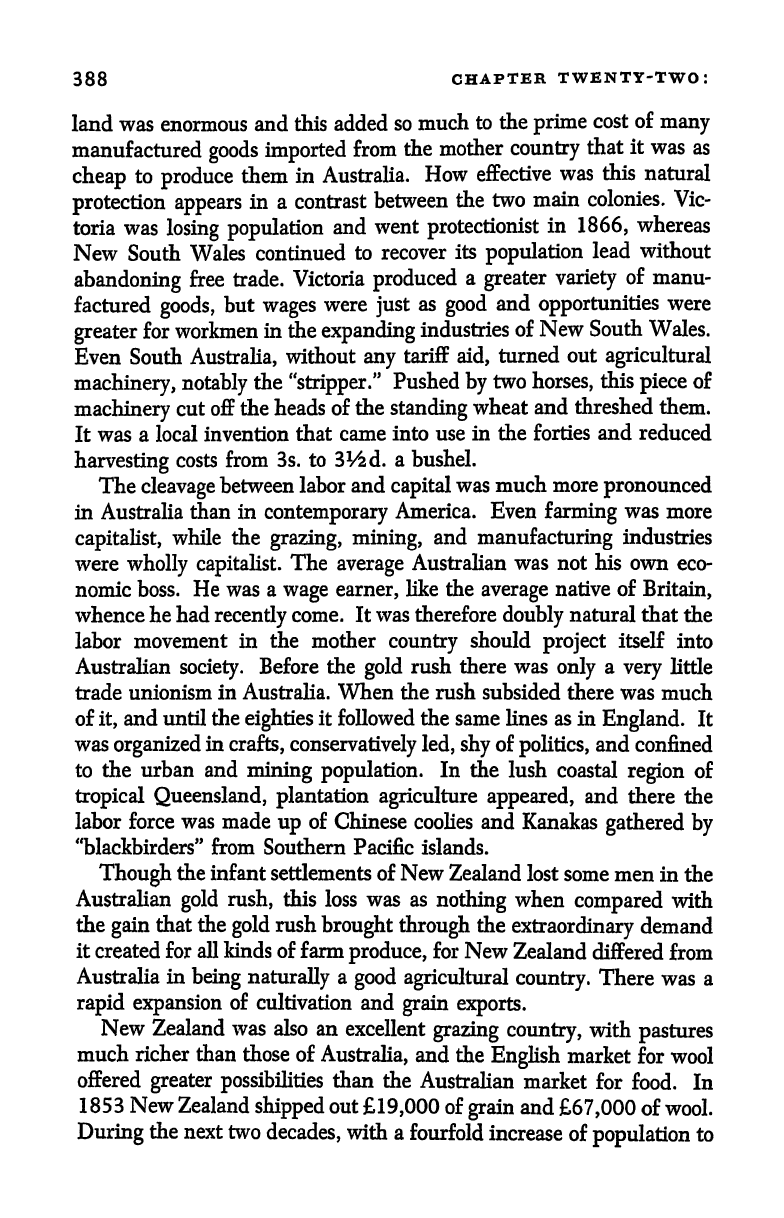
388
CHAPTER
TWENTY-TWO:
land was enormous
and
this added
so
much
to
the
prime
cost of
many
manufactured
goods
imported
from
the
mother
country
that
it
was
as
cheap
to
produce
them in
Australia.
How
effective
was
this
natural
protection
appears
in a contrast
between
the
two
main
colonies.
Vic-
toria
was
losing
population
and
went
protectionist
in
1866,
whereas
New South
Wales
continued
to
recover
its
population
lead
without
abandoning
free
trade.
Victoria
produced
a
greater
variety
of
manu-
factured
goods,
but
wages
were
just
as
good
and
opportunities
were
greater
for workmen
in the
expanding
industries
of
New
South Wales.
Even South
Australia,
without
any
tariff
aid,
turned
out
agricultural
machinery,
notably
the
"stripper."
Pushed
by
two
horses,
this
piece
of
machinery
cut
off
the heads of
the
standing
wheat
and
threshed
them.
It
was a local
invention
that
came
into use
in the forties
and
reduced
harvesting
costs
from
3s. to 3Vd.
a
bushel.
The
cleavage
between
labor
and
capital
was much
more
pronounced
in
Australia
than
in
contemporary
America. Even
farming
was
more
capitalist,
while
the
grazing,
mining,
and
manufacturing
industries
were
wholly capitalist.
The
average
Australian
was
not his own
eco-
nomic
boss.
He was a
wage
earner,
like
the
average
native of
Britain,
whence he had
recently
come. It
was
therefore
doubly
natural that the
labor
movement
in
the
mother
country
should
project
itself
into
Australian
society.
Before the
gold
rush there
was
only
a
very
little
trade
unionism
in
Australia.
When
the
rush
subsided there
was
much
of
it,
and until the
eighties
it
followed the same lines as
in
England.
It
was
organized
in
crafts,
conservatively
led,
shy
of
politics,
and
confined
to
the urban and
mining
population.
In the
lush
coastal
region
of
tropical
Queensland,
plantation
agriculture
appeared,
and there the
labor
force
was
made
up
of
Chinese coolies
and Kanakas
gathered
by
"blackbirders" from Southern
Pacific
islands.
Though
the
infant
settlements
of
New
Zealand
lost some
men
in the
Australian
gold
rush,
this loss was as
nothing
when
compared
with
the
gain
that the
gold
rush
brought
through
the
extraordinary
demand
it
created for
all
kinds
of
farm
produce,
for New
Zealand
differed
from
Australia
in
being
naturally
a
good
agricultural
country.
There was a
rapid
expansion
of
cultivation and
grain exports.
New Zealand
was
also an
excellent
grazing
country,
with
pastures
much
richer than those of
Australia,
and the
English
market
for wool
offered
greater
possibilities
than the
Australian
market
for
food.
In
1853
New
Zealand
shipped
out
19,000
of
grain
and
67,000
of
wool.
During
the next
two
decades,
with
a
fourfold
increase of
population
to
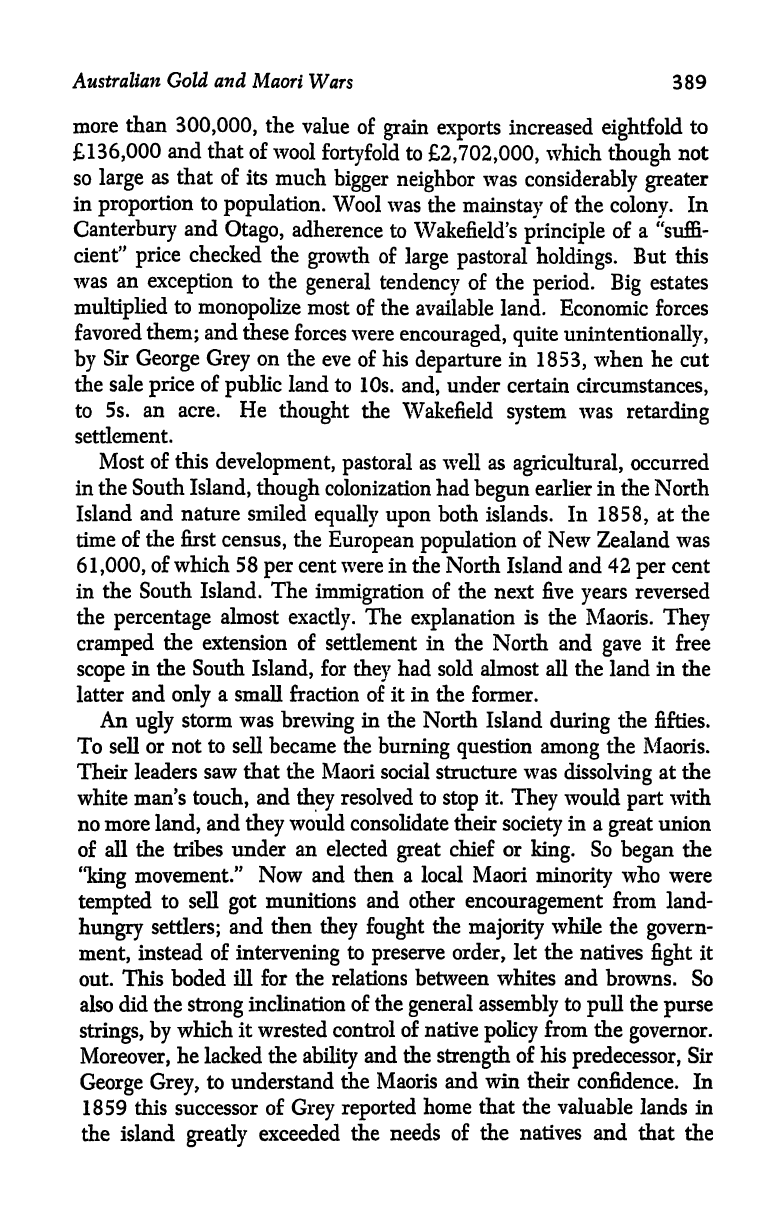
Australian
Gold and
Maori
Wars
389
more
than
300,000,
the
value
of
grain exports
increased
eightfold
to
136,000
and
that
of
wool
fortyfold
to
2,702,000,
which
though
not
so
large
as that
of
its
much
bigger
neighbor
was
considerably
greater
in
proportion
to
population.
Wool
was the
mainstay
of the
colony.
In
Canterbury
and
Otago,
adherence
to
Wakefield's
principle
of
a "suffi-
cient"
price
checked the
growth
of
large
pastoral holdings.
But this
was
an
exception
to the
general
tendency
of
the
period.
Big
estates
multiplied
to
monopolize
most
of
the
available land. Economic
forces
favored
them;
and
these
forces were
encouraged, quite unintentionally,
by
Sir
George Grey
on
the
eve
of
his
departure
in
1853,
when he cut
the
sale
price
of
public
land to
10s.
and,
under certain
circumstances,
to
5s.
an acre. He
thought
the
Wakefield
system
was
retarding
settlement.
Most
of this
development,
pastoral
as
well
as
agricultural,
occurred
in
the South
Island,
though
colonization
had
begun
earlier
in
the North
Island
and nature
smiled
equally upon
both
islands.
In
1858,
at
the
time
of
the first
census,
the
European
population
of New
Zealand
was
61,000,
of which 58
per
cent
were in
the North
Island
and 42
per
cent
in
the South Island.
The
immigration
of
the
next five
years
reversed
the
percentage
almost
exactly.
The
explanation
is
the
Maoris.
They
cramped
the
extension
of
settlement
in the North
and
gave
it
free
scope
in
the South
Island,
for
they
had sold almost all
the
land
in
the
latter
and
only
a
small
fraction
of
it in
the former.
An
ugly
storm
was
brewing
in
the
North
Island
during
the
fifties.
To
sell
or
not to
sell became the
burning question
among
the Maoris.
Their leaders
saw that the Maori
social structure was
dissolving
at
the
white
man's
touch,
and
they
resolved to
stop
it.
They
would
part
with
no
more
land,
and
they
would consolidate
their
society
in a
great
union
of all
the
tribes
under
an
elected
great
chief or
king.
So
began
the
"king
movement."
Now
and then a
local
Maori
minority
who
were
tempted
to
sell
got
munitions and other
encouragement
from
land-
hungry
settlers;
and then
they fought
the
majority
while
the
govern-
ment,
instead
of
intervening
to
preserve
order,
let
the
natives
fight
it
out.
This boded
ill for
the relations between whites
and browns.
So
also
did
the
strong
inclination of
the
general assembly
to
pull
the
purse
strings,
by
which
it wrested
control of
native
policy
from
the
governor.
Moreover,
he
lacked
the
ability
and the
strength
of his
predecessor,
Sir
George
Grey,
to understand
the Maoris and win
their
confidence.
In
1859 this successor of
Grey
reported
home
that the valuable
lands
in
the island
greatly
exceeded
the needs
of
the
natives
and
that the
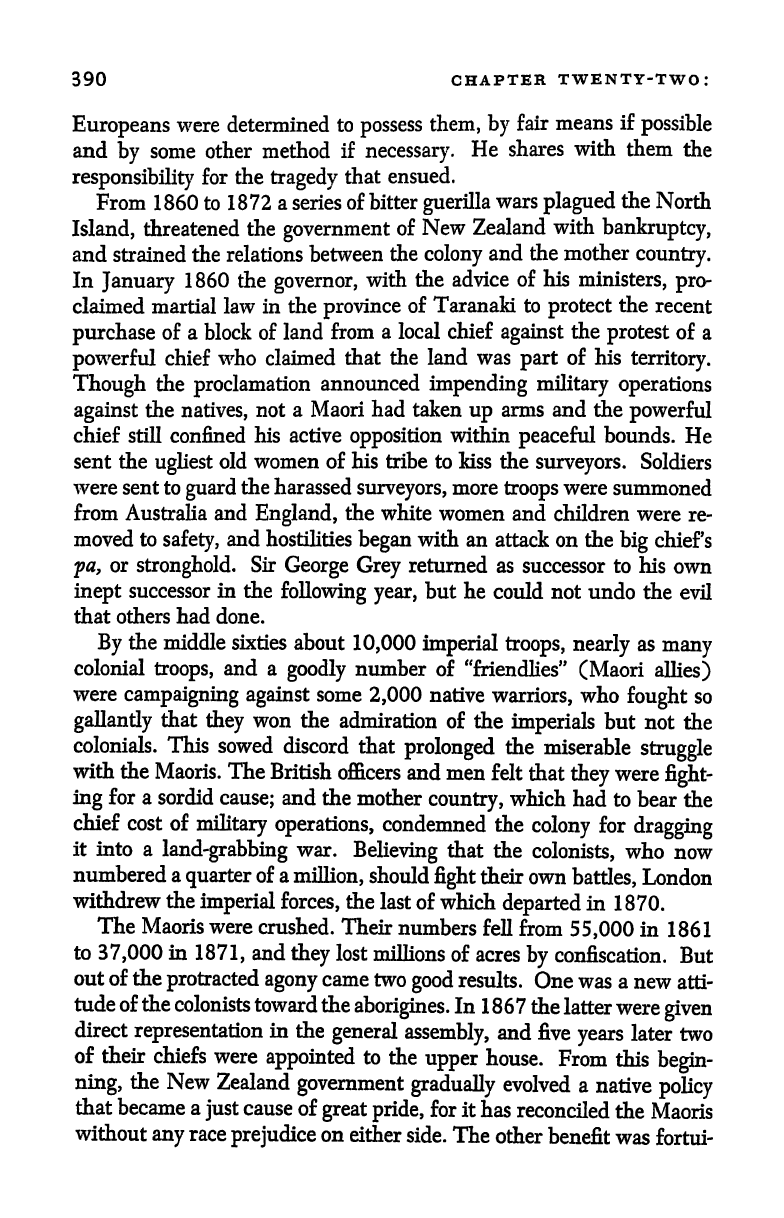
390
CHAPTER
TWENTY-TWO:
Europeans
were determined
to
possess
them,
by
fair
means if
possible
and
by
some
other
method
if
necessary.
He
shares
with
them
the
responsibility
for
the
tragedy
that
ensued.
From
1860 to 1872
a series
of
bitter
guerilla
wars
plagued
the
North
Island,
threatened
the
government
of
New
Zealand
with
bankruptcy,
and
strained
the
relations
between
the
colony
and
the mother
country.
In
January
1860 the
governor,
with the
advice
of his
ministers,
pro-
claimed martial law
in the
province
of
Taranaki
to
protect
the
recent
purchase
of a
block of
land
from
a
local chief
against
the
protest
of a
powerful
chief
who claimed
that
the land was
part
of
his
territory.
Though
the
proclamation
announced
impending military operations
against
the
natives,
not
a Maori had taken
up
arms and die
powerful
chief
still
confined
his
active
opposition
within
peaceful
bounds.
He
sent the
ugliest
old women of his
tribe
to kiss the
surveyors.
Soldiers
were sent to
guard
the
harassed
surveyors,
more
troops
were
summoned
from Australia and
England,
the
white
women and
children
were re-
moved
to
safety,
and
hostilities
began
with
an
attack on the
big
chiefs
pa,
or
stronghold.
Sir
George Grey
returned as
successor to
his
own
inept
successor in the
following
year,
but he
could
not
undo the
evil
that others had
done.
By
the
middle sixties
about
10,000
imperial
troops, nearly
as
many
colonial
troops,
and
a
goodly
number
of
"friendlies"
(Maori
allies)
were
campaigning against
some
2,000
native
warriors,
who
fought
so
gallantly
that
they
won
the
admiration
of the
imperials
but
not
the
colonials. This
sowed
discord
that
prolonged
the
miserable
struggle
with
the
Maoris. The
British
officers
and men
felt
that
they
were
fight-
ing
for a
sordid
cause;
and the
mother
country,
which
had to
bear
the
chief cost of
military
operations,
condemned the
colony
for
dragging
it into a
land-grabbing
war.
Believing
that the
colonists,
who
now
numbered a
quarter
of a
million,
should
fight
their own
battles,
London
withdrew the
imperial
forces,
the last
of
which
departed
in
1870.
The
Maoris were
crushed.
Their
numbers
fell
from
55,000
in
1861
to
37,000
in
1871,
and
they
lost
millions
of
acres
by
confiscation.
But
out
of
the
protracted
agony
came
two
good
results.
One
was a
new
atti-
tude of
the
colonists
toward the
aborigines.
In
1 867
the
latter
were
given
direct
representation
in
the
general
assembly,
and
five
years
later two
of
their
chiefs
were
appointed
to
the
upper
house.
From
this
begin-
ning,
the
New
Zealand
government
gradually
evolved
a
native
policy
that became a
just
cause
of
great
pride,
for
it
has
reconciled
the
Maoris
without
any
race
prejudice
on
either
side. The
other
benefit
was
fortui-
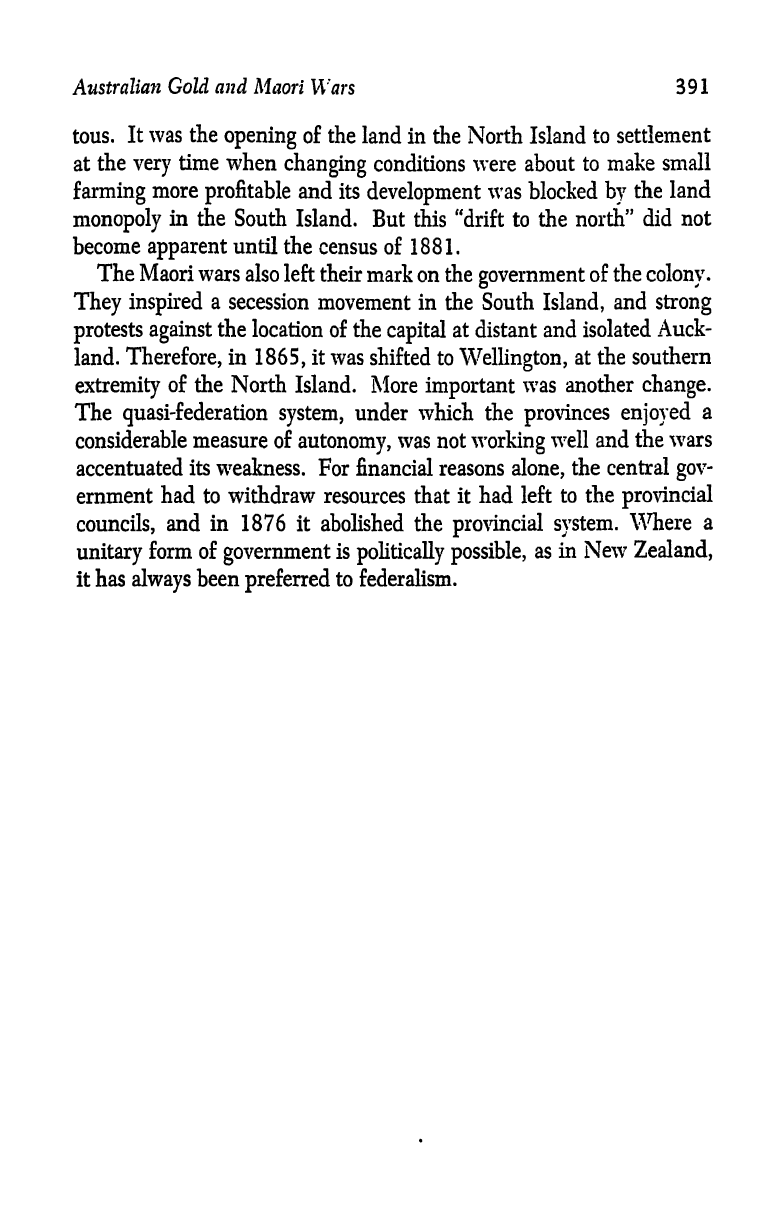
Australian
Gold
and
Maori
Wars
391
tous.
It
was
the
opening
of the land
in the
North Island
to settlement
at
the
very
time
when
changing
conditions
were about
to
make
small
farming
more
profitable
and its
development
was blocked
by
the
land
monopoly
in
the
South
Island. But
this "drift
to the
north"
did
not
become
apparent
until the
census of 1881.
The
Maori
wars
also left
their
mark on
the
government
of
the
colony.
They inspired
a
secession
movement
in
the
South
Island,
and
strong
protests
against
the
location of the
capital
at
distant
and
isolated
Auck-
land.
Therefore,
in
1865,
it
was
shifted to
Wellington,
at
the
southern
extremity
of the
North
Island. More
important
was another
change.
The
quasi-federation system,
under
which
the
provinces
enjoyed
a
considerable
measure of
autonomy,
was
not
working
well and
the
wars
accentuated
its
weakness.
For
financial reasons
alone,
the central
gov-
ernment
had to
withdraw resources that it
had left
to the
provincial
councils,
and
in
1876 it abolished
the
provincial
system.
Where
a
unitary
form of
government
is
politically possible,
as
in
New
Zealand,
it
has
always
been
preferred
to federalism.
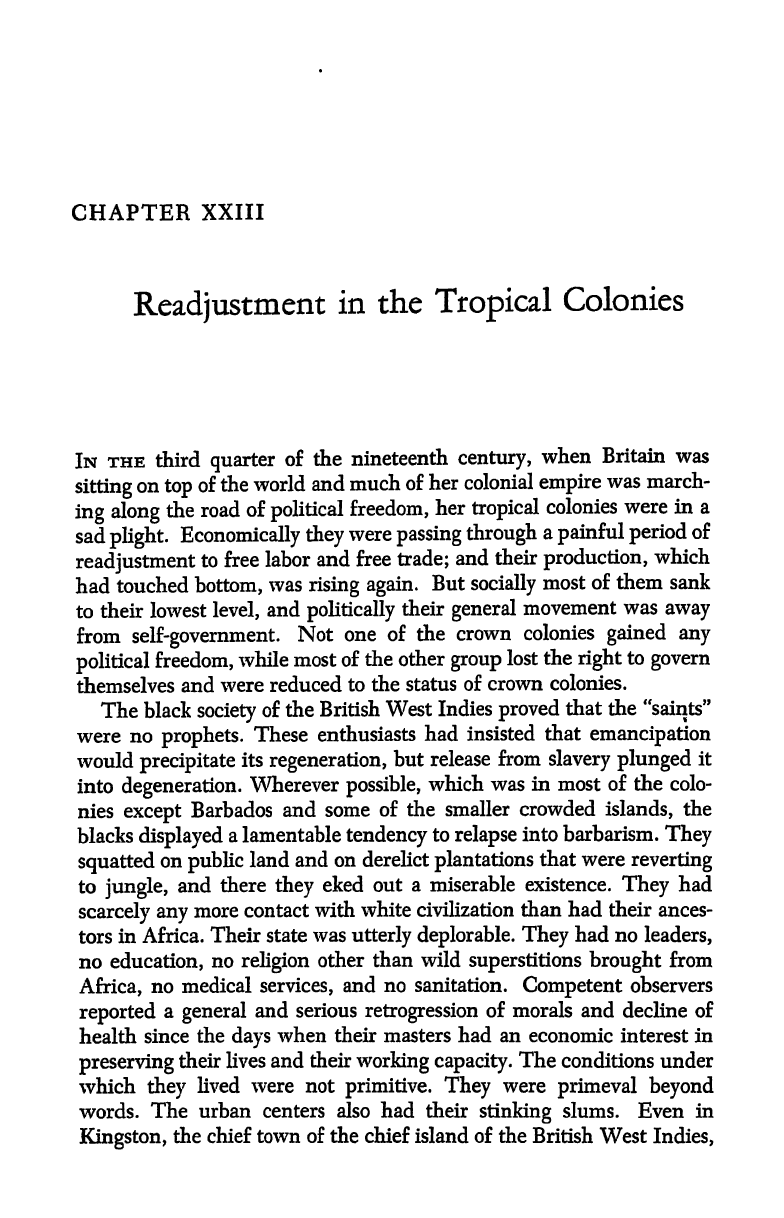
CHAPTER
XXIII
Readjustment
in
the
Tropical
Colonies
IN
THE
third
quarter
of
the
nineteenth
century,
when
Britain
was
sitting
on
top
of
the
world
and
much
of
her
colonial
empire
was march-
ing
along
the
road
of
political
freedom,
her
tropical
colonies
were in a
sad
plight.
Economically
they
were
passing
through
a
painful
period
of
readjustment
to
free
labor
and free
trade;
and
their
production,
which
had
touched
bottom,
was
rising
again.
But
socially
most
of
them sank
to
their lowest
level,
and
politically
their
general
movement
was
away
from
self-government.
Not
one
of the
crown
colonies
gained
any
political
freedom,
while
most of
the
other
group
lost
the
right
to
govern
themselves
and
were reduced
to the
status
of
crown colonies.
The
black
society
of
the
British
West
Indies
proved
that
the
"saints"
were
no
prophets.
These
enthusiasts
had
insisted
that
emancipation
would
precipitate
its
regeneration,
but
release
from
slavery
plunged
it
into
degeneration.
Wherever
possible,
which was
in
most
of the colo-
nies
except
Barbados
and some
of the
smaller crowded
islands,
the
blacks
displayed
a
lamentable
tendency
to
relapse
into barbarism.
They
squatted
on
public
land
and on derelict
plantations
that were
reverting
to
jungle,
and
there
they
eked out
a miserable existence.
They
had
scarcely
any
more
contact
with
white civilization
than
had
their
ances-
tors
in
Africa.
Their state
was
utterly deplorable.
They
had no
leaders,
no
education,
no
religion
other than wild
superstitions
brought
from
Africa,
no
medical
services,
and no
sanitation.
Competent
observers
reported
a
general
and serious
retrogression
of morals
and decline of
health
since
the
days
when
their
masters
had an
economic interest
in
preserving
their lives
and
their
working
capacity.
The
conditions under
which
they
lived
were not
primitive.
They
were
primeval
beyond
words.
The urban
centers also had their
stinking
slums. Even in
Kingston,
the chief town
of
the chief island
of the
British
West
Indies,
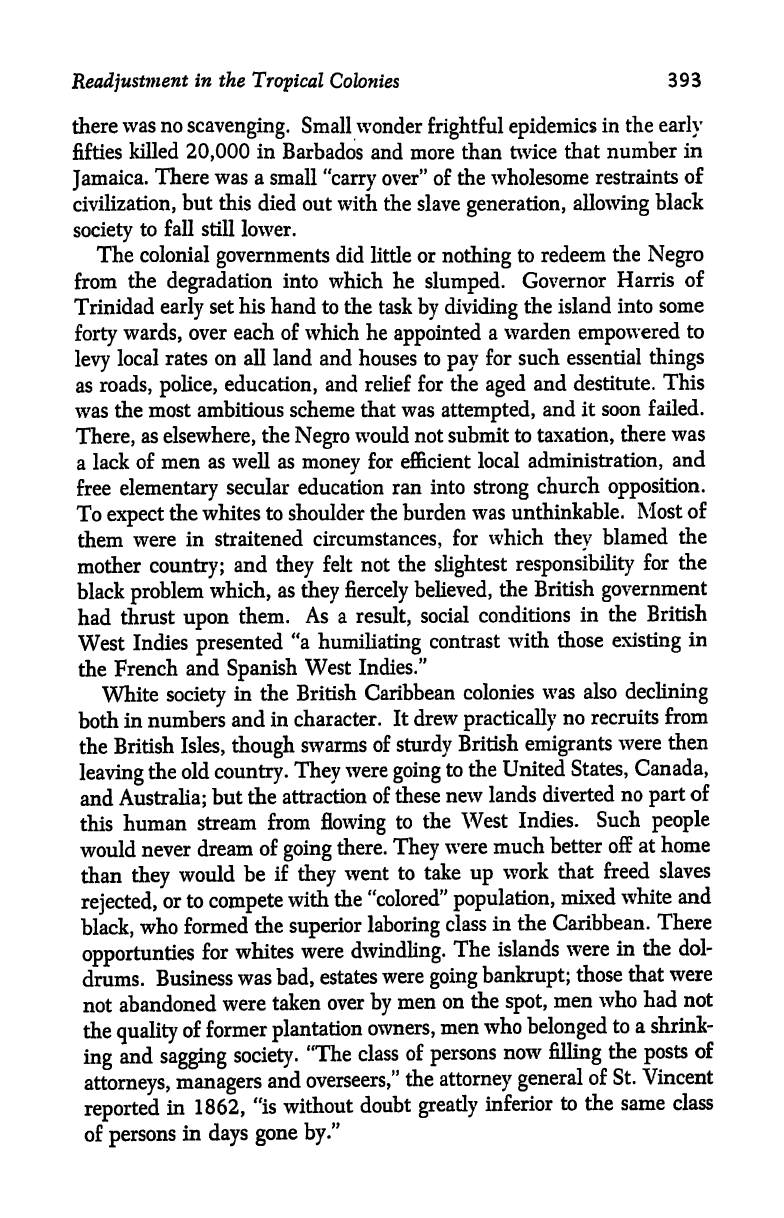
Readjustment
in
the
Tropical
Colonies
393
there
was no
scavenging.
Small
wonder
frightful
epidemics
in
the
early
fifties
killed
20,000
in
Barbados
and more
than
twice
that
number
in
Jamaica.
There
was a
small
"carry
over" of
the wholesome
restraints
of
civilization,
but
this died out
with the
slave
generation,
allowing
black
society
to
fall
still
lower.
The
colonial
governments
did
little or
nothing
to redeem
the
Negro
from
the
degradation
into
which
he
slumped.
Governor
Harris
of
Trinidad
early
set his hand
to the task
by
dividing
the island
into
some
forty
wards,
over each
of which he
appointed
a
warden
empowered
to
levy
local
rates on all land
and houses to
pay
for
such
essential
things
as
roads,
police,
education,
and
relief
for
the
aged
and
destitute.
This
was
the
most ambitious
scheme that
was
attempted,
and it
soon failed.
There,
as
elsewhere,
the
Negro
would
not submit
to
taxation,
there
was
a
lack
of
men as well as
money
for
efficient
local
administration,
and
free
elementary
secular
education
ran into
strong
church
opposition.
To
expect
the
whites to
shoulder
the burden
was
unthinkable.
Most
of
them
were
in
straitened
circumstances,
for
which
they
blamed
the
mother
country;
and
they
felt
not
the
slightest
responsibility
for
the
black
problem
which,
as
they
fiercely
believed,
the British
government
had
thrust
upon
them.
As a
result,
social
conditions
in
the
British
West
Indies
presented
"a
humiliating
contrast
with those
existing
in
the
French
and
Spanish
West
Indies."
White
society
in
the British
Caribbean
colonies
was
also
declining
both
in
numbers
and
in character.
It
drew
practically
no
recruits
from
the
British
Isles,
though
swarms
of
sturdy
British
emigrants
were
then
leaving
the
old
country.
They
were
going
to the
United
States,
Canada,
and
Australia;
but
the
attraction
of
these
new
lands
diverted
no
part
of
this
human
stream
from
flowing
to
the West
Indies.
Such
people
would
never
dream
of
going
there.
They
were
much
better off
at
home
than
they
would
be
if
they
went
to
take
up
work
that freed
slaves
rejected,
or
to
compete
with
the
"colored"
population,
mixed
white and
black,
who
formed
the
superior
laboring
class
in
the Caribbean.
There
opportunties
for
whites
were
dwindling.
The islands
were
in the dol-
drums.
Business
was
bad,
estates
were
going
bankrupt;
those
that
were
not
abandoned
were
taken
over
by
men
on
the
spot,
men who
had
not
the
quality
of
former
plantation
owners,
men
who
belonged
to
a
shrink-
ing
and
sagging
society.
"The
class
of
persons
now
filling
the
posts
of
attorneys,
managers
and
overseers,"
the
attorney general
of St.
Vincent
reported
in
1862,
"is
without
doubt
greatly
inferior
to
the
same class
of
persons
in
days
gone
by."
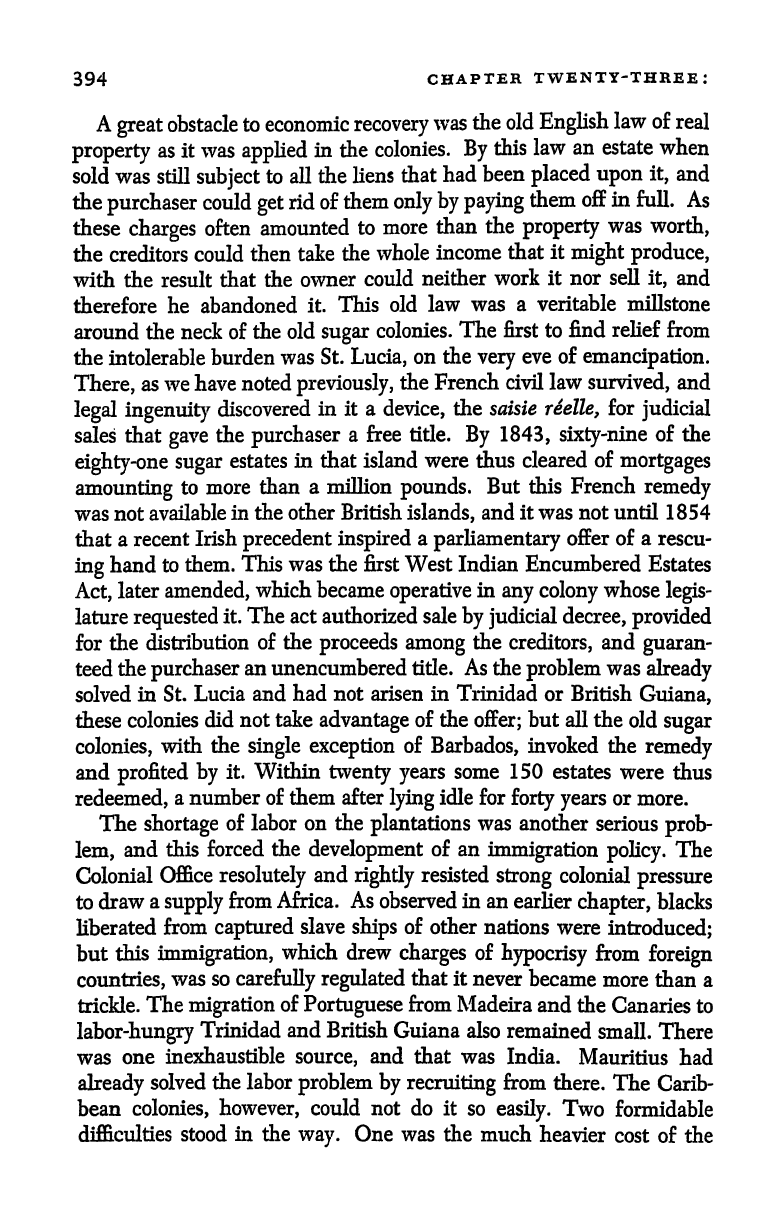
394
CHAPTER
TWENTY-THREE:
A
great
obstacle
to economic
recovery
was
the
old
English
law
of
real
property
as
it was
applied
in
the
colonies.
By
this
law
an estate
when
sold was still
subject
to
all
the
liens
that
had
been
placed
upon
it,
and
the
purchaser
could
get
rid
of
them
only
by paying
them
off in
full.
As
these
charges
often
amounted
to
more
than
the
property
was
worth,
the creditors could
then
take
the
whole
income
that
it
might
produce,
with
the result
that
the owner
could
neither
work
it nor sell
it,
and
therefore
he
abandoned
it.
This
old
law
was
a veritable
millstone
around
the
neck of
the old
sugar
colonies.
The first to
find
relief
from
the
intolerable
burden
was
St.
Lucia,
on the
very
eve of
emancipation.
There,
as we
have noted
previously,
the French civil law
survived,
and
legal ingenuity
discovered
in it a
device,
the saisie
reelle,
for
judicial
sales
that
gave
the
purchaser
a free title.
By
1843,
sixty-nine
of
the
eighty-one
sugar
estates
in that
island
were
thus
cleared
of
mortgages
amounting
to
more
than
a
million
pounds.
But this French
remedy
was not
available
in the
other British
islands,
and
it
was not until
1854
that
a recent
Irish
precedent inspired
a
parliamentary
offer
of
a
rescu-
ing
hand
to
them.
This
was
the first West Indian Encumbered
Estates
Act,
later
amended,
which became
operative
in
any colony
whose
legis-
lature
requested
it. The act
authorized
sale
by judicial
decree,
provided
for
the distribution
of the
proceeds
among
the
creditors,
and
guaran-
teed
the
purchaser
an unencumbered
title. As the
problem
was
already
solved
in St.
Lucia and
had not arisen in
Trinidad or British
Guiana,
these
colonies
did not take
advantage
of
the
offer;
but
all the
old
sugar
colonies,
with
the
single
exception
of
Barbados,
invoked
the
remedy
and
profited
by
it. Within
twenty
years
some 150
estates
were
thus
redeemed,
a number of them
after
lying
idle
for
forty years
or
more.
The
shortage
of labor
on the
plantations
was
another
serious
prob-
lem,
and
this
forced
the
development
of an
immigration
policy.
The
Colonial
Office
resolutely
and
rightly
resisted
strong
colonial
pressure
to draw
a
supply
from
Africa. As
observed in an
earlier
chapter,
blacks
liberated
from
captured
slave
ships
of
other
nations were
introduced;
but
this
immigration,
which
drew
charges
of
hypocrisy
from
foreign
countries,
was
so
carefully
regulated
that
it
never
became
more
than
a
trickle.
The
migration
of
Portuguese
from Madeira
and the
Canaries
to
labor-hungry
Trinidad
and
British
Guiana also
remained
small. There
was
one
inexhaustible
source,
and that
was
India.
Mauritius had
already
solved
the labor
problem
by
recruiting
from
there.
The
Carib-
bean
colonies, however,
could not do
it so
easily.
Two
formidable
difficulties
stood
in the
way.
One was the
much
heavier
cost
of the
